NISSAN PATROL 2000 Electronic Service Manual
Manufacturer: NISSAN, Model Year: 2000, Model line: PATROL, Model: NISSAN PATROL 2000Pages: 1033, PDF Size: 30.71 MB
Page 41 of 1033
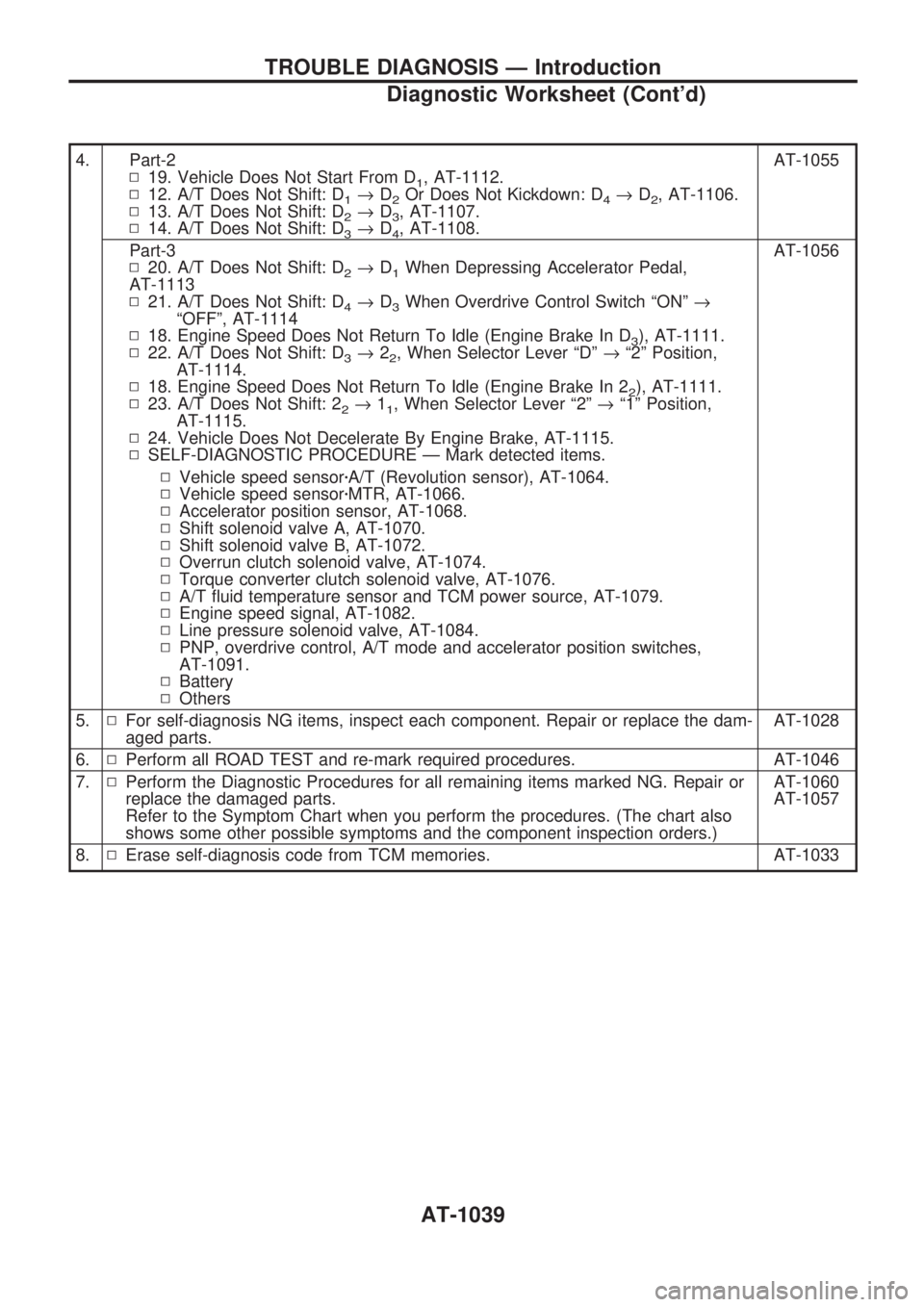
4. Part-2
N19. Vehicle Does Not Start From D
1, AT-1112.
N12. A/T Does Not Shift: D
1®D2Or Does Not Kickdown: D4®D2, AT-1106.
N13. A/T Does Not Shift: D
2®D3, AT-1107.
N14. A/T Does Not Shift: D
3®D4, AT-1108.AT-1055
Part-3
N20. A/T Does Not Shift: D
2®D1When Depressing Accelerator Pedal,
AT-1113
N21. A/T Does Not Shift: D
4®D3When Overdrive Control Switch ªONº®
ªOFFº, AT-1114
N18. Engine Speed Does Not Return To Idle (Engine Brake In D
3), AT-1111.
N22. A/T Does Not Shift: D
3®22, When Selector Lever ªDº®ª2º Position,
AT-1114.
N18. Engine Speed Does Not Return To Idle (Engine Brake In 2
2), AT-1111.
N23. A/T Does Not Shift: 2
2®11, When Selector Lever ª2º®ª1º Position,
AT-1115.
N24. Vehicle Does Not Decelerate By Engine Brake, AT-1115.
NSELF-DIAGNOSTIC PROCEDURE Ð Mark detected items.AT-1056
NVehicle speed sensorzA/T (Revolution sensor), AT-1064.
NVehicle speed sensorzMTR, AT-1066.
NAccelerator position sensor, AT-1068.
NShift solenoid valve A, AT-1070.
NShift solenoid valve B, AT-1072.
NOverrun clutch solenoid valve, AT-1074.
NTorque converter clutch solenoid valve, AT-1076.
NA/T fluid temperature sensor and TCM power source, AT-1079.
NEngine speed signal, AT-1082.
NLine pressure solenoid valve, AT-1084.
NPNP, overdrive control, A/T mode and accelerator position switches,
AT-1091.
NBattery
NOthers
5.NFor self-diagnosis NG items, inspect each component. Repair or replace the dam-
aged parts.AT-1028
6.NPerform all ROAD TEST and re-mark required procedures. AT-1046
7.NPerform the Diagnostic Procedures for all remaining items marked NG. Repair or
replace the damaged parts.
Refer to the Symptom Chart when you perform the procedures. (The chart also
shows some other possible symptoms and the component inspection orders.)AT-1060
AT-1057
8.NErase self-diagnosis code from TCM memories. AT-1033
TROUBLE DIAGNOSIS Ð Introduction
Diagnostic Worksheet (Cont'd)
AT-1039
Page 42 of 1033
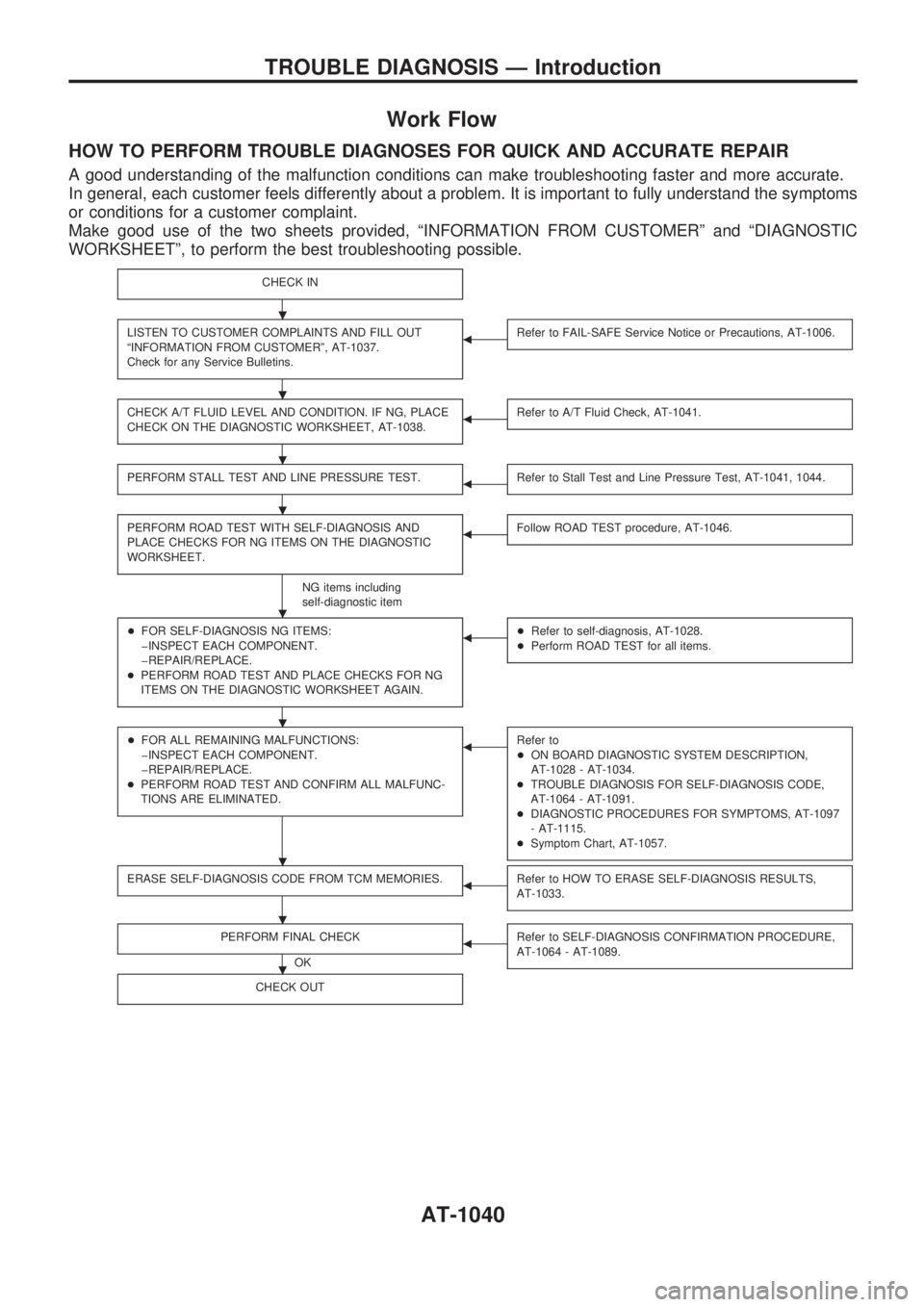
Work Flow
HOW TO PERFORM TROUBLE DIAGNOSES FOR QUICK AND ACCURATE REPAIR
A good understanding of the malfunction conditions can make troubleshooting faster and more accurate.
In general, each customer feels differently about a problem. It is important to fully understand the symptoms
or conditions for a customer complaint.
Make good use of the two sheets provided, ªINFORMATION FROM CUSTOMERº and ªDIAGNOSTIC
WORKSHEETº, to perform the best troubleshooting possible.
CHECK IN
LISTEN TO CUSTOMER COMPLAINTS AND FILL OUT
ªINFORMATION FROM CUSTOMERº, AT-1037.
Check for any Service Bulletins.bRefer to FAIL-SAFE Service Notice or Precautions, AT-1006.
CHECK A/T FLUID LEVEL AND CONDITION. IF NG, PLACE
CHECK ON THE DIAGNOSTIC WORKSHEET, AT-1038.bRefer to A/T Fluid Check, AT-1041.
PERFORM STALL TEST AND LINE PRESSURE TEST.bRefer to Stall Test and Line Pressure Test, AT-1041, 1044.
PERFORM ROAD TEST WITH SELF-DIAGNOSIS AND
PLACE CHECKS FOR NG ITEMS ON THE DIAGNOSTIC
WORKSHEET.
NG items including
self-diagnostic item
bFollow ROAD TEST procedure, AT-1046.
+FOR SELF-DIAGNOSIS NG ITEMS:
þINSPECT EACH COMPONENT.
þREPAIR/REPLACE.
+PERFORM ROAD TEST AND PLACE CHECKS FOR NG
ITEMS ON THE DIAGNOSTIC WORKSHEET AGAIN.b+Refer to self-diagnosis, AT-1028.
+Perform ROAD TEST for all items.
+FOR ALL REMAINING MALFUNCTIONS:
þINSPECT EACH COMPONENT.
þREPAIR/REPLACE.
+PERFORM ROAD TEST AND CONFIRM ALL MALFUNC-
TIONS ARE ELIMINATED.bRefer to
+ON BOARD DIAGNOSTIC SYSTEM DESCRIPTION,
AT-1028 - AT-1034.
+TROUBLE DIAGNOSIS FOR SELF-DIAGNOSIS CODE,
AT-1064 - AT-1091.
+DIAGNOSTIC PROCEDURES FOR SYMPTOMS, AT-1097
- AT-1115.
+Symptom Chart, AT-1057.
ERASE SELF-DIAGNOSIS CODE FROM TCM MEMORIES.bRefer to HOW TO ERASE SELF-DIAGNOSIS RESULTS,
AT-1033.
PERFORM FINAL CHECK
OK
bRefer to SELF-DIAGNOSIS CONFIRMATION PROCEDURE,
AT-1064 - AT-1089.
CHECK OUT
.
.
.
.
.
.
.
.
.
TROUBLE DIAGNOSIS Ð Introduction
AT-1040
Page 43 of 1033
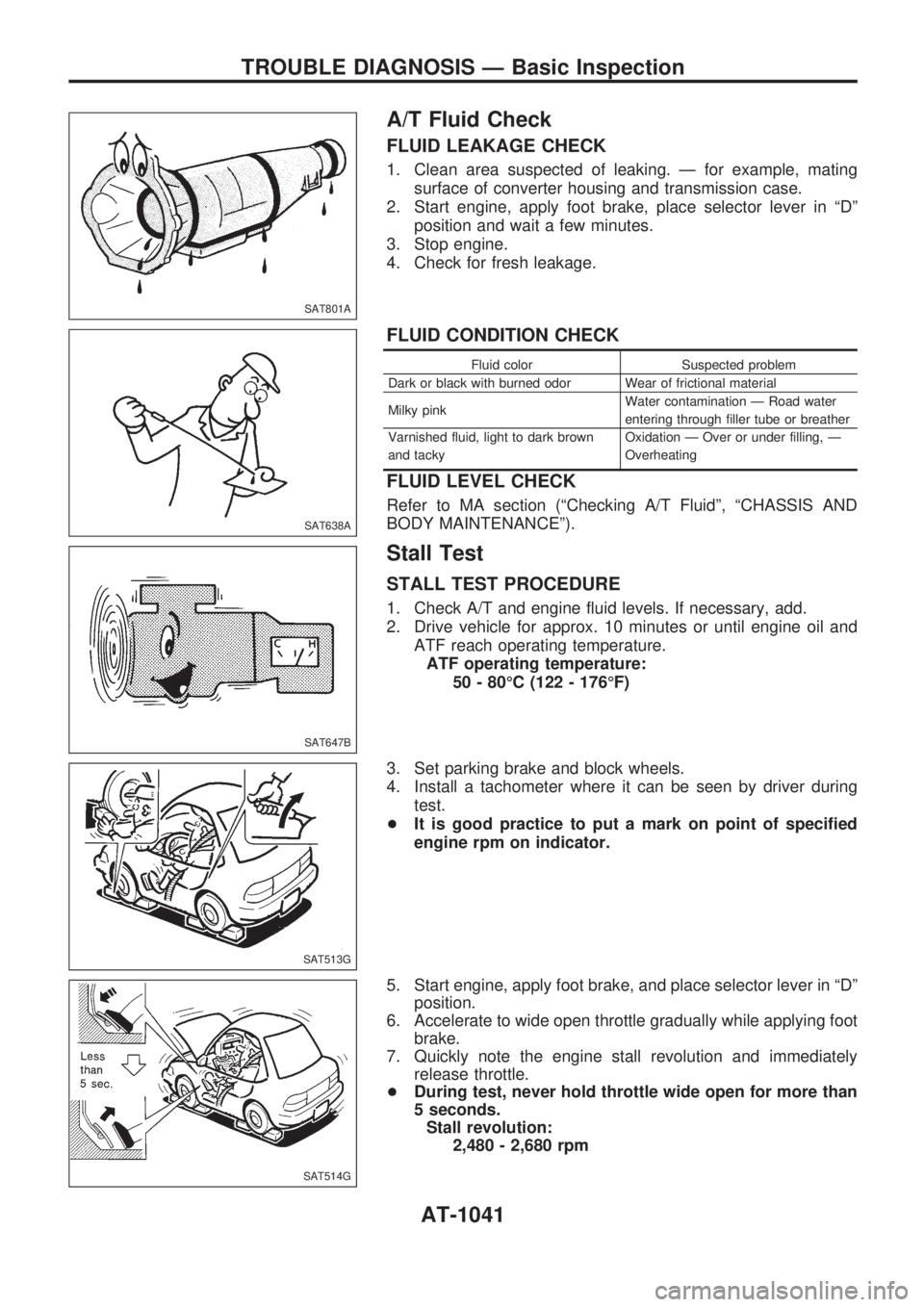
A/T Fluid Check
FLUID LEAKAGE CHECK
1. Clean area suspected of leaking. Ð for example, mating
surface of converter housing and transmission case.
2. Start engine, apply foot brake, place selector lever in ªDº
position and wait a few minutes.
3. Stop engine.
4. Check for fresh leakage.
FLUID CONDITION CHECK
Fluid color Suspected problem
Dark or black with burned odor Wear of frictional material
Milky pinkWater contamination Ð Road water
entering through filler tube or breather
Varnished fluid, light to dark brown
and tackyOxidation Ð Over or under filling, Ð
Overheating
FLUID LEVEL CHECK
Refer to MA section (ªChecking A/T Fluidº, ªCHASSIS AND
BODY MAINTENANCEº).
Stall Test
STALL TEST PROCEDURE
1. Check A/T and engine fluid levels. If necessary, add.
2. Drive vehicle for approx. 10 minutes or until engine oil and
ATF reach operating temperature.
ATF operating temperature:
50 - 80ÉC (122 - 176ÉF)
3. Set parking brake and block wheels.
4. Install a tachometer where it can be seen by driver during
test.
+It is good practice to put a mark on point of specified
engine rpm on indicator.
5. Start engine, apply foot brake, and place selector lever in ªDº
position.
6. Accelerate to wide open throttle gradually while applying foot
brake.
7. Quickly note the engine stall revolution and immediately
release throttle.
+During test, never hold throttle wide open for more than
5 seconds.
Stall revolution:
2,480 - 2,680 rpm
SAT801A
SAT638A
SAT647B
SAT513G
SAT514G
TROUBLE DIAGNOSIS Ð Basic Inspection
AT-1041
Page 44 of 1033
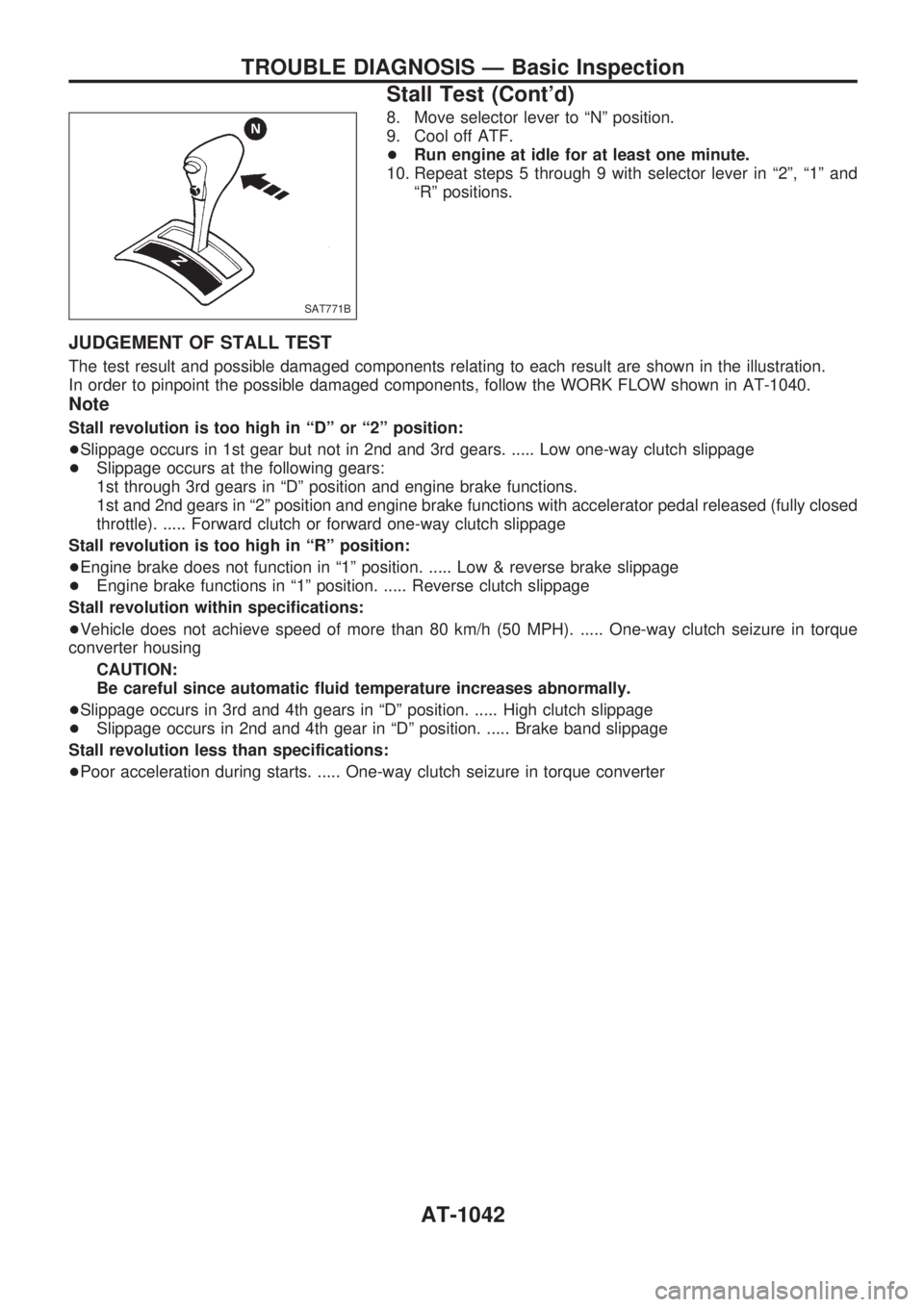
8. Move selector lever to ªNº position.
9. Cool off ATF.
+Run engine at idle for at least one minute.
10. Repeat steps 5 through 9 with selector lever in ª2º, ª1º and
ªRº positions.
JUDGEMENT OF STALL TEST
The test result and possible damaged components relating to each result are shown in the illustration.
In order to pinpoint the possible damaged components, follow the WORK FLOW shown in AT-1040.
Note
Stall revolution is too high in ªDº or ª2º position:
+Slippage occurs in 1st gear but not in 2nd and 3rd gears. ..... Low one-way clutch slippage
+Slippage occurs at the following gears:
1st through 3rd gears in ªDº position and engine brake functions.
1st and 2nd gears in ª2º position and engine brake functions with accelerator pedal released (fully closed
throttle). ..... Forward clutch or forward one-way clutch slippage
Stall revolution is too high in ªRº position:
+Engine brake does not function in ª1º position. ..... Low & reverse brake slippage
+Engine brake functions in ª1º position. ..... Reverse clutch slippage
Stall revolution within specifications:
+Vehicle does not achieve speed of more than 80 km/h (50 MPH). ..... One-way clutch seizure in torque
converter housing
CAUTION:
Be careful since automatic fluid temperature increases abnormally.
+Slippage occurs in 3rd and 4th gears in ªDº position. ..... High clutch slippage
+Slippage occurs in 2nd and 4th gear in ªDº position. ..... Brake band slippage
Stall revolution less than specifications:
+Poor acceleration during starts. ..... One-way clutch seizure in torque converter
SAT771B
TROUBLE DIAGNOSIS Ð Basic Inspection
Stall Test (Cont'd)
AT-1042
Page 45 of 1033
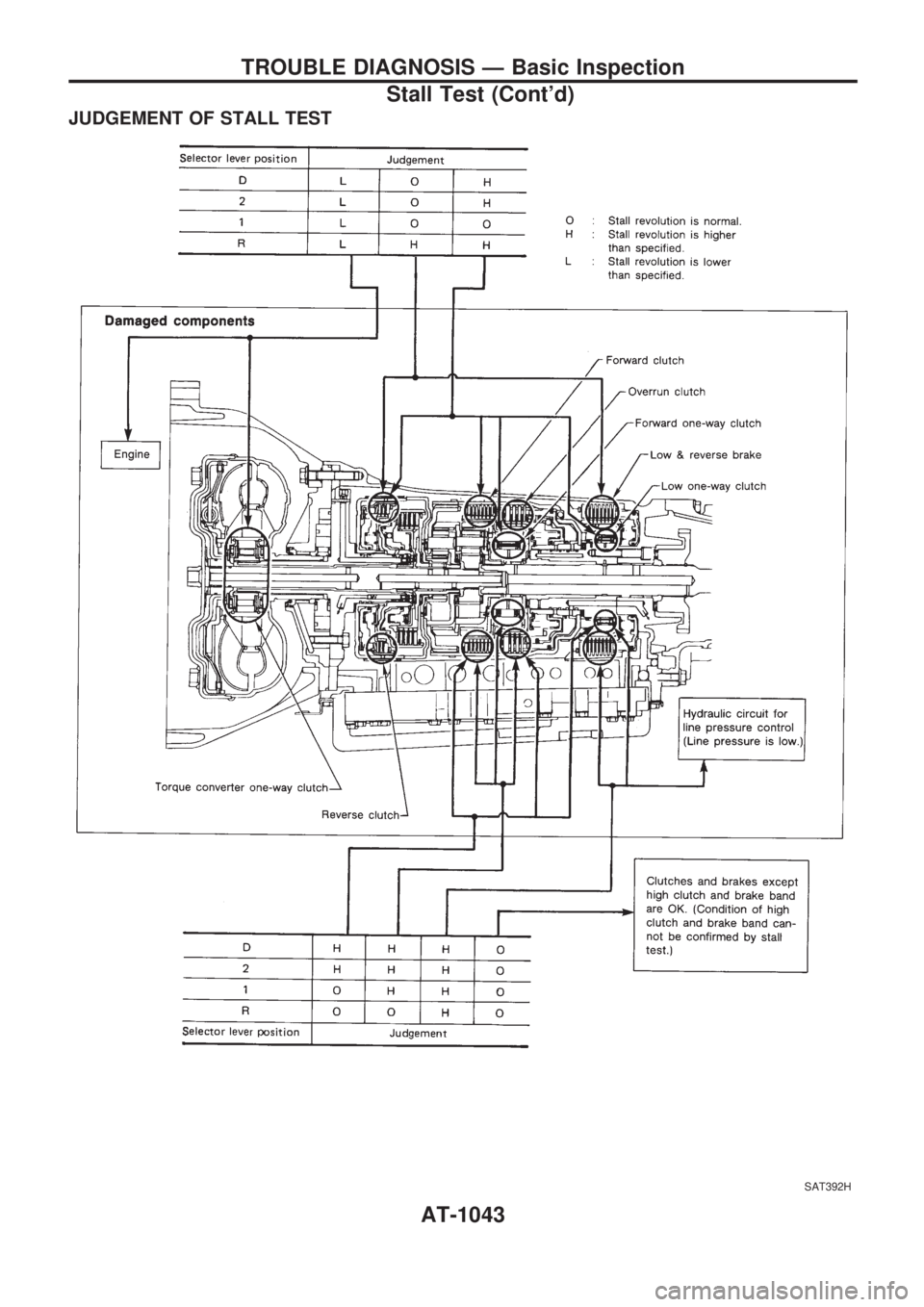
JUDGEMENT OF STALL TEST
SAT392H
TROUBLE DIAGNOSIS Ð Basic Inspection
Stall Test (Cont'd)
AT-1043
Page 46 of 1033
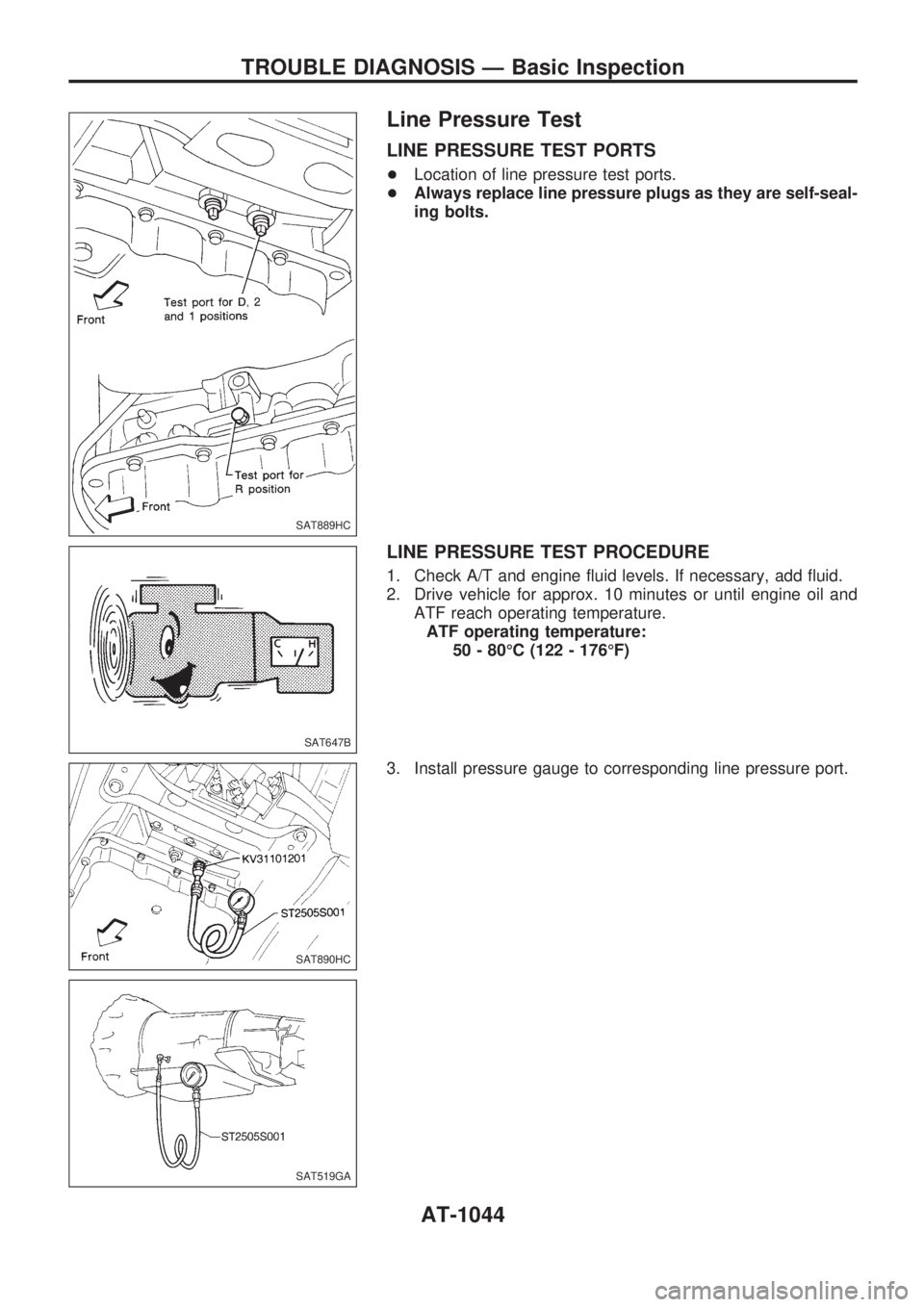
Line Pressure Test
LINE PRESSURE TEST PORTS
+Location of line pressure test ports.
+Always replace line pressure plugs as they are self-seal-
ing bolts.
LINE PRESSURE TEST PROCEDURE
1. Check A/T and engine fluid levels. If necessary, add fluid.
2. Drive vehicle for approx. 10 minutes or until engine oil and
ATF reach operating temperature.
ATF operating temperature:
50 - 80ÉC (122 - 176ÉF)
3. Install pressure gauge to corresponding line pressure port.
SAT889HC
SAT647B
SAT890HC
SAT519GA
TROUBLE DIAGNOSIS Ð Basic Inspection
AT-1044
Page 47 of 1033
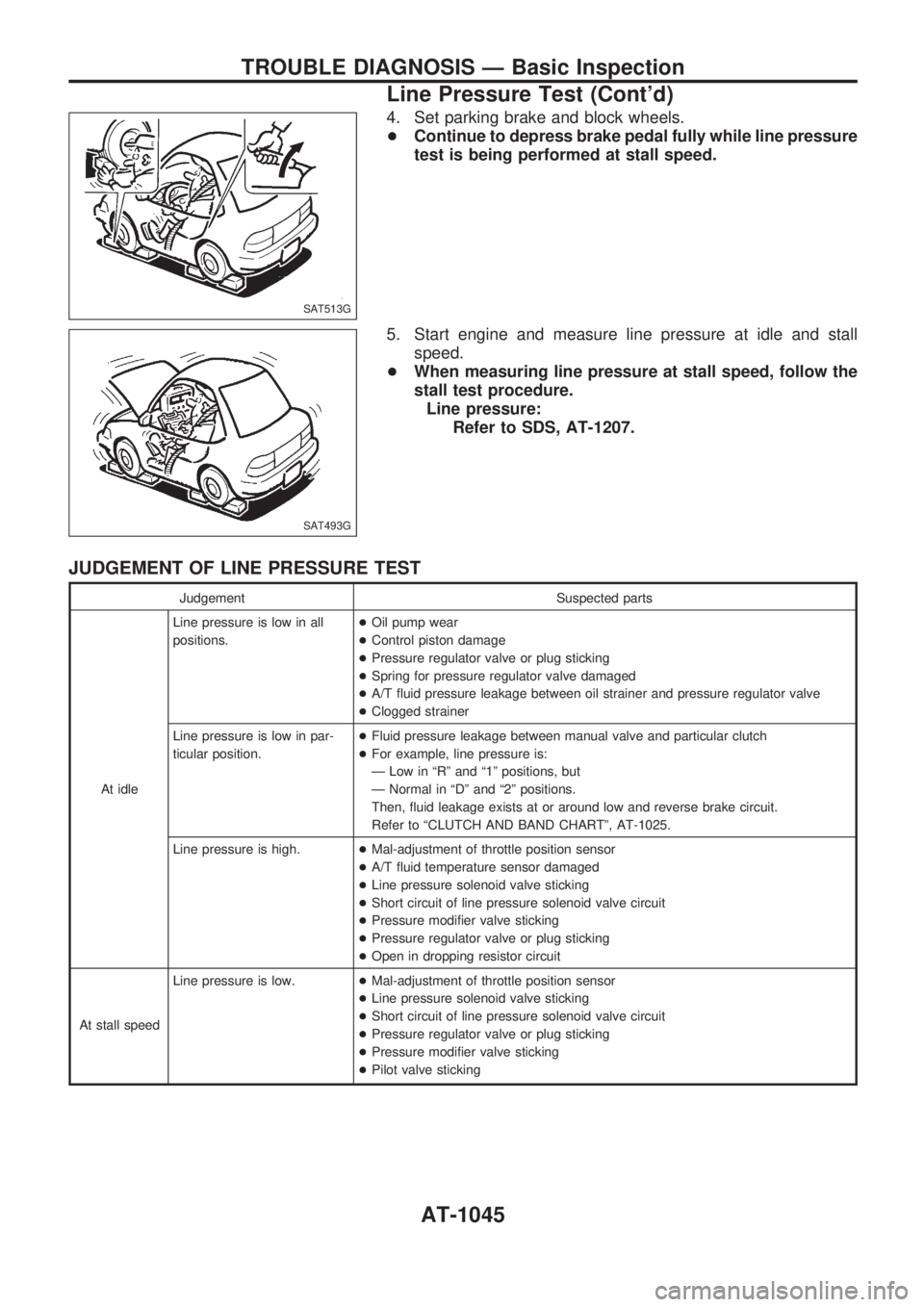
4. Set parking brake and block wheels.
+Continue to depress brake pedal fully while line pressure
test is being performed at stall speed.
5. Start engine and measure line pressure at idle and stall
speed.
+When measuring line pressure at stall speed, follow the
stall test procedure.
Line pressure:
Refer to SDS, AT-1207.
JUDGEMENT OF LINE PRESSURE TEST
Judgement Suspected parts
At idleLine pressure is low in all
positions.+Oil pump wear
+Control piston damage
+Pressure regulator valve or plug sticking
+Spring for pressure regulator valve damaged
+A/T fluid pressure leakage between oil strainer and pressure regulator valve
+Clogged strainer
Line pressure is low in par-
ticular position.+Fluid pressure leakage between manual valve and particular clutch
+For example, line pressure is:
Ð Low in ªRº and ª1º positions, but
Ð Normal in ªDº and ª2º positions.
Then, fluid leakage exists at or around low and reverse brake circuit.
Refer to ªCLUTCH AND BAND CHARTº, AT-1025.
Line pressure is high.+Mal-adjustment of throttle position sensor
+A/T fluid temperature sensor damaged
+Line pressure solenoid valve sticking
+Short circuit of line pressure solenoid valve circuit
+Pressure modifier valve sticking
+Pressure regulator valve or plug sticking
+Open in dropping resistor circuit
At stall speedLine pressure is low.+Mal-adjustment of throttle position sensor
+Line pressure solenoid valve sticking
+Short circuit of line pressure solenoid valve circuit
+Pressure regulator valve or plug sticking
+Pressure modifier valve sticking
+Pilot valve sticking
SAT513G
SAT493G
TROUBLE DIAGNOSIS Ð Basic Inspection
Line Pressure Test (Cont'd)
AT-1045
Page 48 of 1033
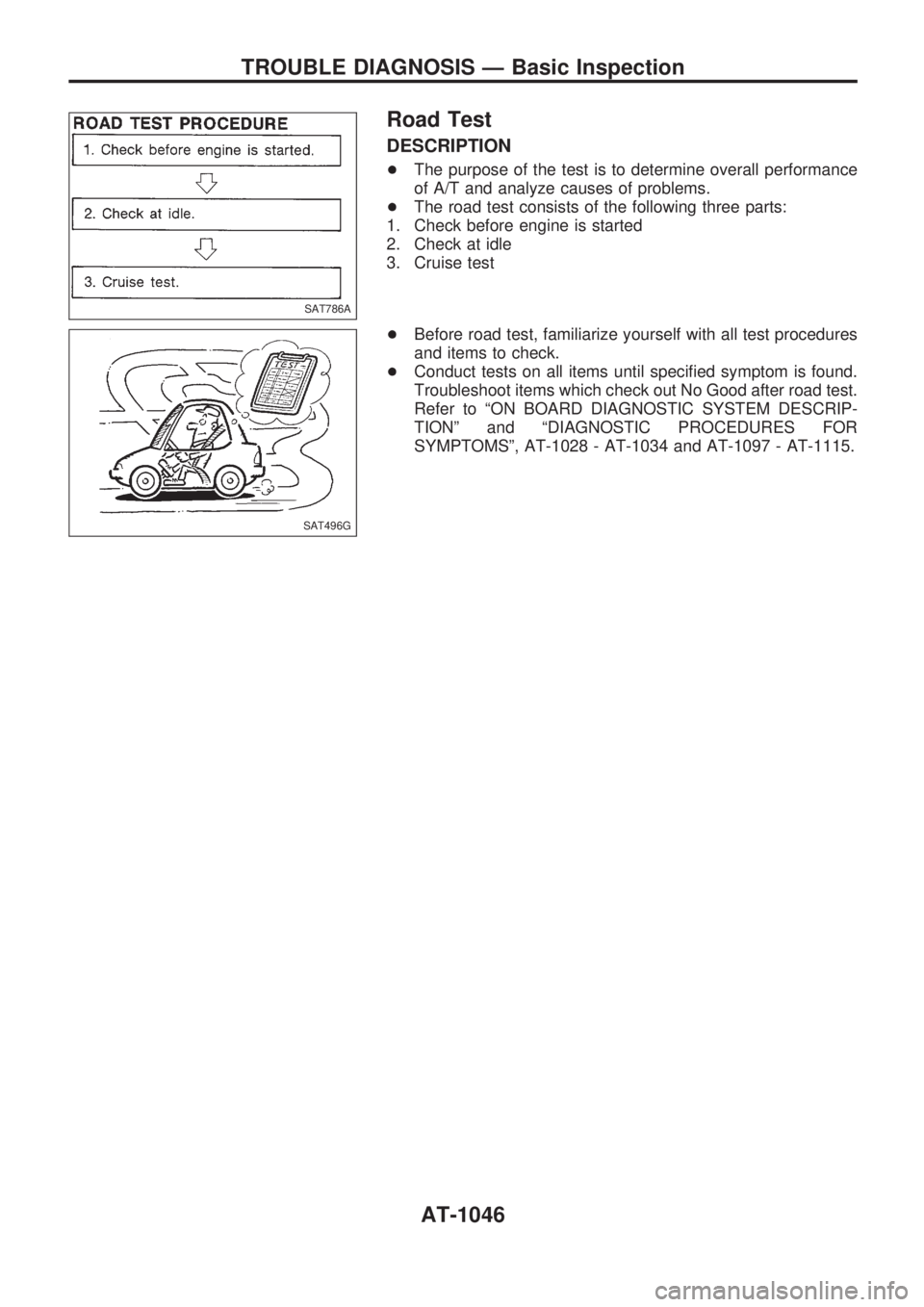
Road Test
DESCRIPTION
+The purpose of the test is to determine overall performance
of A/T and analyze causes of problems.
+The road test consists of the following three parts:
1. Check before engine is started
2. Check at idle
3. Cruise test
+Before road test, familiarize yourself with all test procedures
and items to check.
+Conduct tests on all items until specified symptom is found.
Troubleshoot items which check out No Good after road test.
Refer to ªON BOARD DIAGNOSTIC SYSTEM DESCRIP-
TIONº and ªDIAGNOSTIC PROCEDURES FOR
SYMPTOMSº, AT-1028 - AT-1034 and AT-1097 - AT-1115.
SAT786A
SAT496G
TROUBLE DIAGNOSIS Ð Basic Inspection
AT-1046
Page 49 of 1033
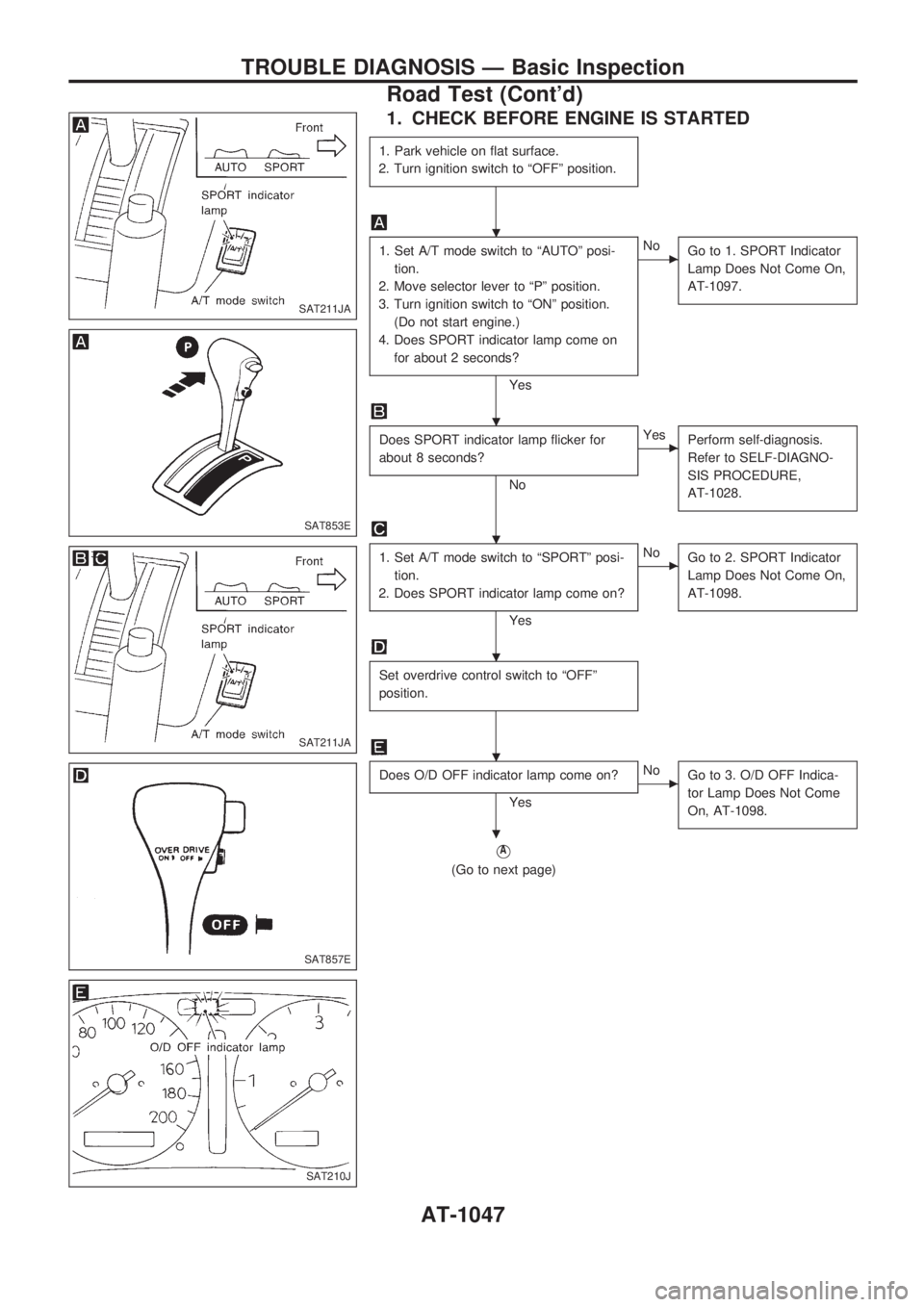
1. CHECK BEFORE ENGINE IS STARTED
1. Park vehicle on flat surface.
2. Turn ignition switch to ªOFFº position.
1. Set A/T mode switch to ªAUTOº posi-
tion.
2. Move selector lever to ªPº position.
3. Turn ignition switch to ªONº position.
(Do not start engine.)
4. Does SPORT indicator lamp come on
for about 2 seconds?
Yes
cNo
Go to 1. SPORT Indicator
Lamp Does Not Come On,
AT-1097.
Does SPORT indicator lamp flicker for
about 8 seconds?
No
cYes
Perform self-diagnosis.
Refer to SELF-DIAGNO-
SIS PROCEDURE,
AT-1028.
1. Set A/T mode switch to ªSPORTº posi-
tion.
2. Does SPORT indicator lamp come on?
Yes
cNo
Go to 2. SPORT Indicator
Lamp Does Not Come On,
AT-1098.
Set overdrive control switch to ªOFFº
position.
Does O/D OFF indicator lamp come on?
Yes
cNo
Go to 3. O/D OFF Indica-
tor Lamp Does Not Come
On, AT-1098.
VA
(Go to next page)
SAT211JA
SAT853E
SAT211JA
SAT857E
SAT210J
.
.
.
.
.
.
TROUBLE DIAGNOSIS Ð Basic Inspection
Road Test (Cont'd)
AT-1047
Page 50 of 1033
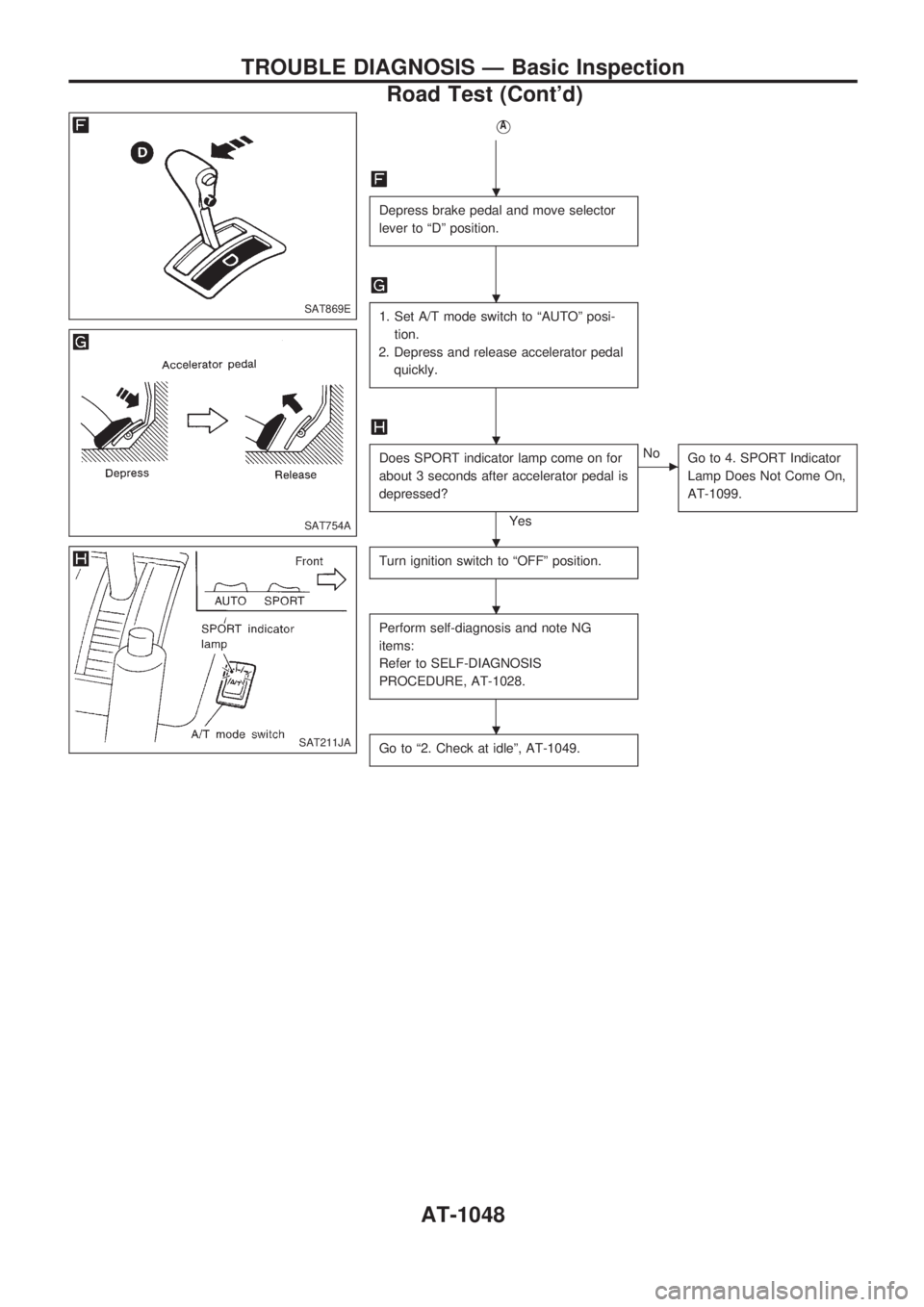
VA
Depress brake pedal and move selector
lever to ªDº position.
1. Set A/T mode switch to ªAUTOº posi-
tion.
2. Depress and release accelerator pedal
quickly.
Does SPORT indicator lamp come on for
about 3 seconds after accelerator pedal is
depressed?
Yes
cNo
Go to 4. SPORT Indicator
Lamp Does Not Come On,
AT-1099.
Turn ignition switch to ªOFFº position.
Perform self-diagnosis and note NG
items:
Refer to SELF-DIAGNOSIS
PROCEDURE, AT-1028.
Go to ª2. Check at idleº, AT-1049.
SAT869E
SAT754A
SAT211JA
.
.
.
.
.
.
TROUBLE DIAGNOSIS Ð Basic Inspection
Road Test (Cont'd)
AT-1048